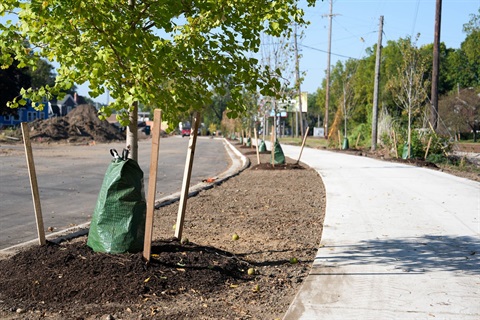Kalamazoo Grows Greener As City Steps Up Expand Tree Canopy
Published on April 17, 2025

Earth Day and Arbor Day are in the month of April. It is a month where trees receive a prominent focus in the city of Kalamazoo. Over the past five years, the City of Kalamazoo has planted between 300 to 500 trees annually; the City also trims many other trees to remove damage and to make sure people are not hurt. Trees deliver Kalamazoo residents with a multitude of environmental, economic, and societal benefits, and the City of Kalamazoo is serious about protecting and enhancing its tree canopy.
The City of Kalamazoo establishes guidelines for enhancing its tree canopy and the lifespan of trees, and there is a tree committee consisting of several City staff and community and utility company representatives. The City also has an arborist dedicated to protecting trees. In addition, the City of Kalamazoo provides a City of Kalamazoo Tree Manual that guides the community in the best practices for planting, maintaining, and protecting trees in an urban environment. The City of Kalamazoo has jurisdiction over all trees located within the public right-of-way (ROW), or the City-owned easement for public infrastructure, such as roads, sidewalks, utilities, and other public services, which typically extends from the street to beyond the curb or sidewalk.
The health of the City’s trees is of utmost importance, according to Brian LaBelle, forestry supervisor in the City of Kalamazoo’s Public Works Division. “Our trees are a significant part of the urban infrastructure,” said LaBelle. “It is critical to maintain and protect our trees to preserve and grow the collective benefits they provide.”
The lifespan of urban trees is a complex issue and concern. Many urban trees live a significantly shorter lifespan than their potential, with a general average for street trees being around 19 to 28 years. LaBelle said there are several primary factors impacting the lifespan of trees in an urban environment such as Kalamazoo. They include:
- Improper care and installation: A major factor contributing to the shorter lifespan of urban trees and manifested in several ways:
-
- Incorrect planting: Planting trees too deep.
- Improper pruning: Topping trees (cutting back large branches to stubs), leading to the growth of weak branches and creating entry points for insects and diseases.
- Improper mulching: Applying mulch directly against the trunk or in a layer too deep.
- Environmental stresses: Several challenging conditions for tree survival:
-
- Pollution: Trees exposed to various pollutants that can negatively impact their health.
- Poor soil: Urban soils poor in quality and lacking the necessary nutrients for healthy tree growth.
- Limited root space: Buildings, pavements, and underground infrastructure often restricting the space available for root growth.
- Altered site drainage: Development that can change the natural drainage patterns, negatively affecting soil moisture levels.
- Soil compaction: Heavy equipment and foot traffic compacting the soil, making it difficult for roots to grow and absorb water and nutrients.
- Increased temperatures: Warmer temperatures, compared to surrounding rural areas, can stress trees.
- Extreme weather: Susceptible to damage from storms, high winds, and other extreme weather events.
- Pests and diseases: Stressed urban trees more vulnerable to attacks from insects and diseases, which can significantly shorten their lives.
- Development and land use changes: Urban development that often leads to the removal of trees or creates conditions detrimental to their survival, including:
-
- Direct removal for construction.
- Damage to roots during construction activities.
- Changes in the surrounding environment that impact tree health.
- Vehicle Damage: Some trees in vulnerable position and can be repeatedly hit by cars and trucks, resulting in injury or death to both trees and people.
- Lack of consideration for tree needs: Cultural and health requirements of urban trees often not adequately considered or monitored.
- Uncertainty in mortality rates: Lack of long-term studies on urban tree mortality, making it difficult to accurately predict their lifespan and plan for their replacement.
The City of Kalamazoo’s Public Works staff and hired contractors are at work planting trees and replacing those that are dead or diseased on streets as well as on the Downtown Mall. The estimated age of the City’s urban trees may vary, depending on their species. The American Elm tree, for example, has an estimated age of 104 years with a typical “diameter at breast height” (DBH) of 50 inches. Trees such as elms have been impacted from Dutch Elm Disease, which contribute to the declining health of trees. City crews and contractors today are planting Silver Maple and Ash trees to replace the elms that have been lost from the disease.
In 2020, the City of Kalamazoo received a grant to digitize and access the health of all City ROW trees. Annual tree removal contracts have been in place since then, and trees have been removed as needed. A block pruning program to prune and remove dead and diseased trees – supported by a USDA Urban Forestry Grant of $1 million, along with funding from the City of Kalamazoo and the Foundation for Excellence – also has been implemented since 2020 to prune trees in sections. The City’s goal is to prune all ROW trees every nine to 12 years.
“In the spirit of Earth Day and Arbor Day, our plan is to continue identifying and removing trees where necessary and replace them,” said LaBelle. “This helps not only replace the lost canopy from tree removals and fallen trees, but also increases our tree canopy for future generations to enjoy.”